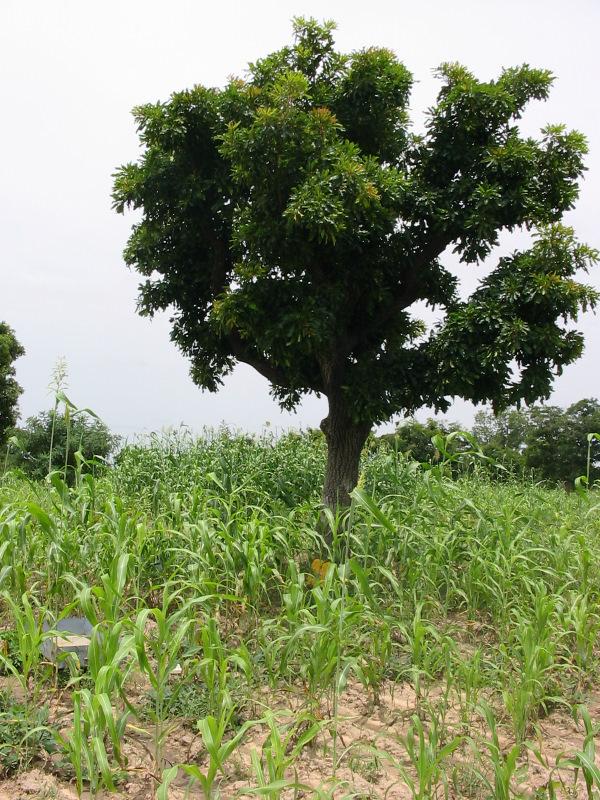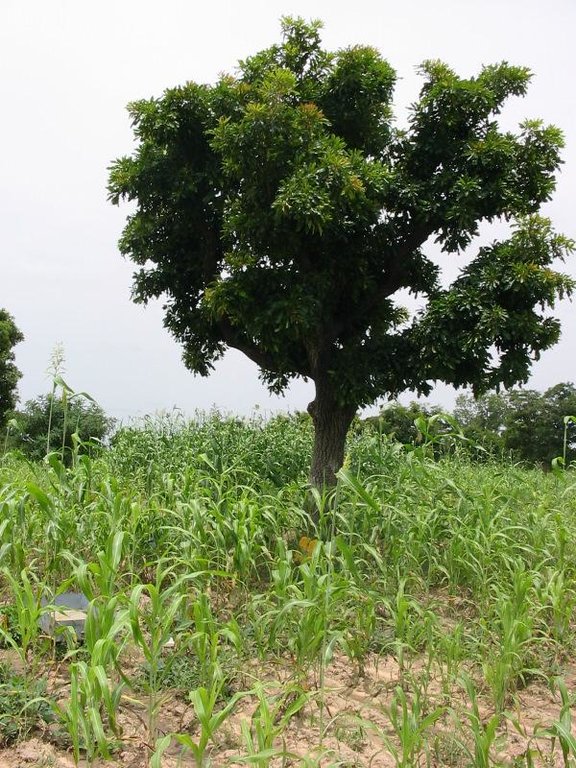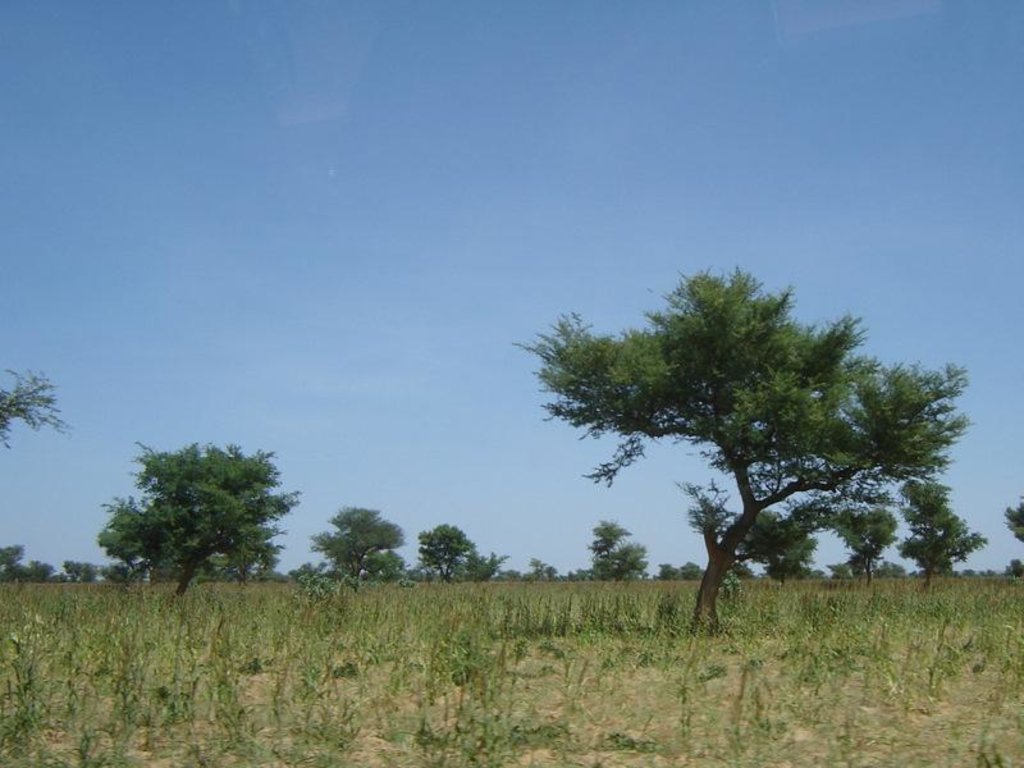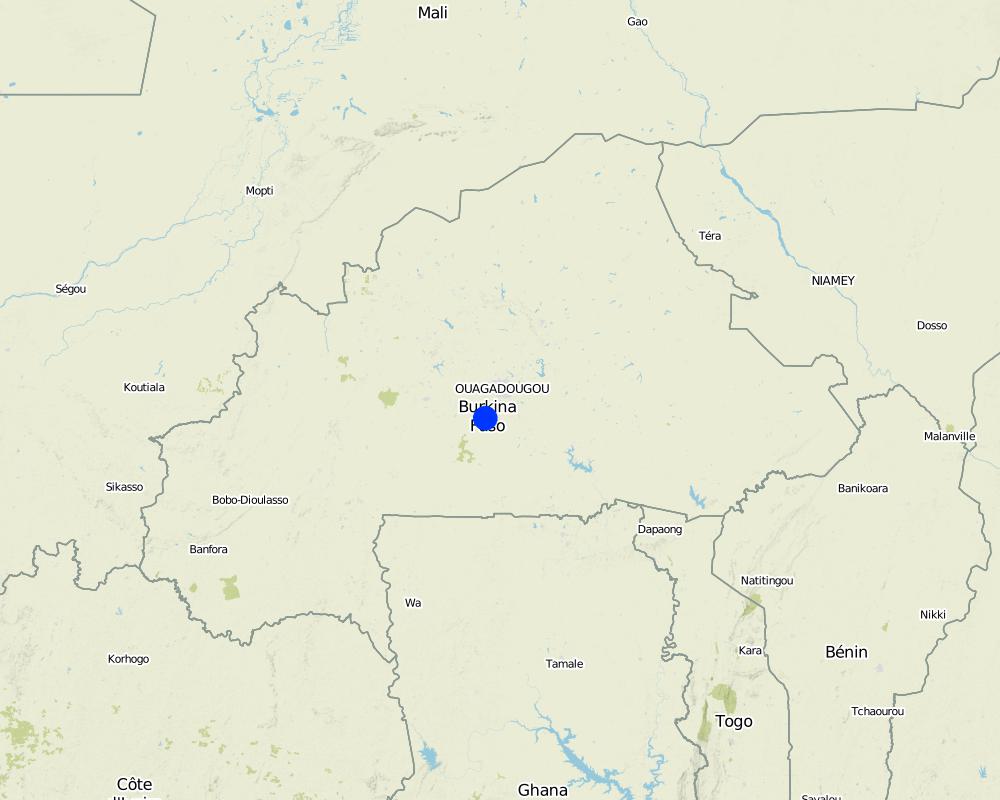Parkland Agroforestry System [布基纳法索]
- 创建:
- 更新:
- 编制者: Unknown User
- 编辑者: –
- 审查者: Fabian Ottiger, Alexandra Gavilano
technologies_1345 - 布基纳法索
查看章节
全部展开 全部收起1. 一般信息
1.2 参与该技术评估和文件编制的资源人员和机构的联系方式
关键资源人
SLM专业人员:
Bayala Jules
Conseil ouest et centre africain pour la recherche et le développement agricoles (CORAF)
布基纳法索
有助于对技术进行记录/评估的项目名称(如相关)
Book project: SLM in Practice - Guidelines and Best Practices for Sub-Saharan Africa (SLM in Practice)有助于对技术进行记录/评估的机构名称(如相关)
West and Central African Council for Agricultural Research and Development (WECARD/CORAF) - 塞内加尔1.3 关于使用通过WOCAT记录的数据的条件
编制者和关键资源人员接受有关使用通过WOCAT记录数据的条件。:
是
2. SLM技术的说明
2.1 技术简介
技术定义:
Parklands are the traditional agroforestry systems of semi-arid West Africa or Sahel where naturally growing, valuable trees are protected and nurtured on cropping and grazing lands
2.2 技术的详细说明
说明:
For the rural people in the Sahel, parkland trees are multipurpose: they are a grocery shop, a pharmacy and a silo at the same time. People rely on many locally cherished species to provide food and nutritional security for both human and livestock populations and to protect and enrich soils. Important tree species are baobab (Adansonia digitata), tamarind (Tamarindus indica), Faidherbia albida, shea nut or karité (Vitellaria paradoxa, see photo 1 below) and néré (Parkia biglobosa). Crop production can be increased below and around the trees (especially under Faidherbida albida) due to the favourable micro-climate, accumulation of soil organic matter through litter fall, prunings and root decay in the predominantly sandy and poor soils.
Parkland management practices include: assisted tree regeneration (see Assisted Natural Regeneration, Burkina Faso; and FMNR, Niger); Tree planting (mostly in vicinity of family compounds); Improved fallows (under which economically useful and fertility-improving trees are planted before cropping is discontinued) and fire protection. Farmers commonly apply silvicultural techniques to increase production of parkland trees. These include seedling protection and fencing, watering, and the selection of vigorous shoots. Pruning is done to improve productivity of trees, reduce shade and enhance understorey crop performance and to produce fuelwood and fodder. It stimulates leaf regrowth, causes an additional foliation peak during the rainy season and depresses pod production. Coppicing and pollarding represent a way of limiting competition with intercrops and providing wood and other tree products in species with good vegetative growth.
2.3 技术照片
2.5 已应用该技术的、本评估所涵盖的国家/地区/地点
国家:
布基纳法索
有关地点的进一步说明:
Saponé
Map
×2.6 实施日期
如果不知道确切的年份,请说明大概的日期:
- 50多年前(传统)
2.7 技术介绍
详细说明该技术是如何引入的:
- 作为传统系统的一部分(> 50 年)
3. SLM技术的分类
3.1 该技术的主要目的
- 改良生产
- 减少、预防、恢复土地退化
- 保护生态系统
- 降低灾害风险
- 创造有益的经济影响
- 创造有益的社会影响
3.2 应用该技术的当前土地利用类型
同一土地单元内混合使用的土地::
是
具体说明混合土地使用(作物/放牧/树木):
- 农林业

农田
- 一年一作
- 乔木与灌木的种植
年作 - 具体指明作物:
- 谷类 - 小米
每年的生长季节数:
- 1
具体说明:
Longest growing period in days: 120

森林/林地
- 植树造林
植树造林:说明树种的起源和组成:
- 混交品种
- Faidherbia albida, Tamarindus indica, Vitellaria paradoxa, Parkia biglobosa, Adansonia digitata
产品和服务:
- 薪材
- 水果和坚果
- 自然保持/保护
- 自然灾害防护
- crop production below trees (microclimate)
注释:
Major land use problems (compiler’s opinion): Desertification, decline of soil organic matter and fertility, soil loss through water erosion
3.4 供水
该技术所应用土地的供水:
- 雨养
3.5 该技术所属的SLM组
- 农业林学
- 轮作制度(轮作、休耕、轮垦)
- 土壤肥力综合管理
3.6 包含该技术的可持续土地管理措施

植物措施
- V1:乔木和灌木覆盖层
注释:
Main measures: vegetative measures
Type of vegetative measures: scattered / dispersed
3.7 该技术强调的主要土地退化类型

土壤水蚀
- Wt:表土流失/地表侵蚀

土壤风蚀
- Et:表土流失

化学性土壤退化
- Cn:肥力下降和有机质含量下降(非侵蚀所致)

生物性退化
- Bc:植被覆盖的减少
- Bq:数量/生物量减少
- Bs:质量和物种组成/多样性的下降

水质恶化
- Ha:干旱化
注释:
Main type of degradation addressed: Wt: loss of topsoil / surface erosion, Et: loss of topsoil, Cn: fertility decline and reduced organic matter content, Bc: reduction of vegetation cover, Bs: quality and species composition /diversity decline
Secondary types of degradation addressed: Bq: quantity / biomass decline, Ha: aridification
3.8 防止、减少或恢复土地退化
具体数量名该技术与土地退化有关的目标:
- 减少土地退化
4. 技术规范、实施活动、投入和成本
4.1 该技术的技术图纸
技术规范(与技术图纸相关):
Technical knowledge required for field staff / advisors: moderate
Technical knowledge required for land users: low
Main technical functions: control of raindrop splash, increase in organic matter, increase in nutrient availability (supply, recycling,…), reduction in wind speed, promotion of vegetation species and varieties (quality, eg palatable fodder)
Secondary technical functions: stabilisation of soil (eg by tree roots against land slides), increase of infiltration, increase of biomass (quantity)
Scattered / dispersed
Vegetative material: T : trees / shrubs
Trees/ shrubs species: Faidherbia albida, Tamarindus indica, Vitellaria paradoxa, Parkia biglobosa, Adansonia digitata
4.3 技术建立活动
| 活动 | 时间(季度) | |
|---|---|---|
| 1. | Retaining saplings from natural regeneration or wildings | before rainy seasons |
| 2. | Planting improved material (early stage) | |
| 3. | Grafting for shortening juvenile phase and improving fruit quality (initiation stage) | |
| 4. | Pruning to form erect canopy | |
| 5. | Protection from animals by dead or live fences |
4.5 维护/经常性活动
| 活动 | 时间/频率 | |
|---|---|---|
| 1. | Weeding around seedlings when necessary | rainy season |
| 2. | Pruning as necessary (pruned branches are dried and used for fuelwood): annually | |
| 3. | Pollarding (pruning of side branches to improve light for understorey crops | |
| 4. | Felling some trees to reduce density as they grow bigger (during dry season) |
4.6 维护/经常性活动所需要的费用和投入(每年)
注释:
Machinery/ tools: All activities carried out by manual labour using machetes (panga) or hoes
Data on costs is not available. However, costs for management of the land use system are low; only some pruning and trimming of trees is needed which is effectively ‘harvesting’ of fodder and wood.
4.7 影响成本的最重要因素
描述影响成本的最决定性因素:
Data on costs is not available. However, costs for management of the land use system are low; only some pruning and trimming of trees is needed which is effectively ‘harvesting’ of fodder and wood.
5. 自然和人文环境
5.1 气候
年降雨量
- < 250毫米
- 251-500毫米
- 501-750毫米
- 751-1,000毫米
- 1,001-1,500毫米
- 1,501-2,000毫米
- 2,001-3,000毫米
- 3,001-4,000毫米
- > 4,000毫米
有关降雨的规范/注释:
Unimodal
农业气候带
- 半干旱
Thermal climate class: tropics
5.2 地形
平均坡度:
- 水平(0-2%)
- 缓降(3-5%)
- 平缓(6-10%)
- 滚坡(11-15%)
- 崎岖(16-30%)
- 陡峭(31-60%)
- 非常陡峭(>60%)
地形:
- 高原/平原
- 山脊
- 山坡
- 山地斜坡
- 麓坡
- 谷底
垂直分布带:
- 0-100 m a.s.l.
- 101-500 m a.s.l.
- 501-1,000 m a.s.l.
- 1,001-1,500 m a.s.l.
- 1,501-2,000 m a.s.l.
- 2,001-2,500 m a.s.l.
- 2,501-3,000 m a.s.l.
- 3,001-4,000 m a.s.l.
- > 4,000 m a.s.l.
关于地形的注释和进一步规范:
Altitudinal zone: 101-500 m a.s.l. (Saponé)
5.3 土壤
平均土层深度:
- 非常浅(0-20厘米)
- 浅(21-50厘米)
- 中等深度(51-80厘米)
- 深(81-120厘米)
- 非常深(> 120厘米)
土壤质地(表土):
- 粗粒/轻(砂质)
- 中粒(壤土、粉土)
表土有机质:
- 低(<1%)
5.6 应用该技术的土地使用者的特征
生产系统的市场定位:
- 混合(生计/商业)
个人或集体:
- 个人/家庭
机械化水平:
- 手工作业
说明土地使用者的其他有关特征:
Difference in the involvement of women and men: poor and better-off farmers (basically everyone who has land)
Population density: 50-100 persons/km2
5.7 应用该技术的土地使用者使用的平均土地面积
- < 0.5 公顷
- 0.5-1 公顷
- 1-2 公顷
- 2-5公顷
- 5-15公顷
- 15-50公顷
- 50-100公顷
- 100-500公顷
- 500-1,000公顷
- 1,000-10,000公顷
- > 10,000公顷
5.8 土地所有权、土地使用权和水使用权
土地使用权:
- 个人
注释:
majority has ownership of the land, few borrow
6. 影响和结论性说明
6.1 该技术的现场影响
社会经济效应
生产
作物生产
注释/具体说明:
through mulching and nutrient pumping
饲料生产
注释/具体说明:
leaves used as fodder during dry season
收入和成本
农业收入
其它社会经济效应
Fruit production
社会文化影响
国家机构
注释/具体说明:
stakeholder interaction
Housing
注释/具体说明:
More timber available
生态影响
土壤
土壤水分
注释/具体说明:
mulching improves infiltration
土壤覆盖层
注释/具体说明:
mulch and canopy cover
土壤流失
养分循环/补给
注释/具体说明:
leaf litter and nutrient recycling
生物多样性:植被、动物
植物多样性
动物多样性
注释/具体说明:
bees, birds, etc
减少气候和灾害风险
风速
注释/具体说明:
affecting crops / homesteads
微气候
6.2 该技术的场外影响已经显现
旱季稳定可靠的水流
下游洪水
下游淤积
Deforestation
注释/具体说明:
Alternative source of fuel and timber
Employment
注释/具体说明:
Tree management and harvesting
6.3 技术对渐变气候以及与气候相关的极端情况/灾害的暴露和敏感性(土地使用者认为的极端情况/灾害)
注释:
Increased tolerance through the use of indigenous species
6.4 成本效益分析
技术收益与技术建立成本相比如何(从土地使用者的角度看)?
短期回报:
稍微积极
长期回报:
非常积极
技术收益与技术维护成本/经常性成本相比如何(从土地使用者的角度看)?
短期回报:
稍微积极
长期回报:
非常积极
6.5 技术采用
如若可行,进行量化(住户数量和/或覆盖面积):
100% of the area covered
在所有采用这项技术的人当中,有多少人是自发的,即未获得任何物质奖励/付款?:
- 91-100%
注释:
100% of land user families have adopted the Technology without any external material support
Comments on spontaneous adoption: 10s of millions of people live in the traditional parklands of Burkina Faso, Mali, Senegal and Niger. In Mali alone an estimated 3.6 million people practice parkland agroforestry with 40 trees per hectare.
6.7 该技术的优点/长处/机会
| 编制者或其他关键资源人员认为的长处/优势/机会 |
|---|
| Generation of several ecological benefits |
| Wood provision for rural as well as urban population |
| Increased food security thanks to fruit production |
6.8 技术的弱点/缺点/风险及其克服方法
| 土地使用者认为的弱点/缺点/风险 | 如何克服它们? |
|---|---|
| Seedlings and wildings not always readily available | encourage local seed collection and setting up of group tree nurseries |
| Livestock sometimes damage the young seedlings | protection by fencing |
| Dry periods result in low seedling survival rates: planting not possible in dry areas | combine technology with fencing |
| Competition with crops | regular pruning of side branches |
| Long period to fruiting | use vegetative propagation of superior trees |
7. 参考和链接
7.2 参考可用出版物
标题、作者、年份、ISBN:
Jonsson K, CK. Ong and JCW. Odongo. 1999. Influence of scattered nere and karite trees on microclimate, soil fertility and millet yield.
可以从哪里获得?成本如何?
Experimental Agriculture 35:39-53.
标题、作者、年份、ISBN:
Bayala J., J. Balesdent, C. Marol, F. Zapata, Z. Teklehaimanot, SJ. Quedrago. 2006. Relative contribution of trees and crops to soil carbon content in a parkland system in Burkina Faso using natural 13C abundance.
可以从哪里获得?成本如何?
Nutrient Cycling in Agroecosystems 76:193-201.
7.3 链接到网络上的相关信息
标题/说明:
Boffa, J.M. 1999. Agroforestry parklands in Sub-Saharan Africa. FAO Conservation guide no.34, Rome, 230pp
URL:
http://www.fao.org/docrep/005/x3940e/X3940E00.htm#TOC
链接和模块
全部展开 全部收起链接
无链接
模块
无模块





